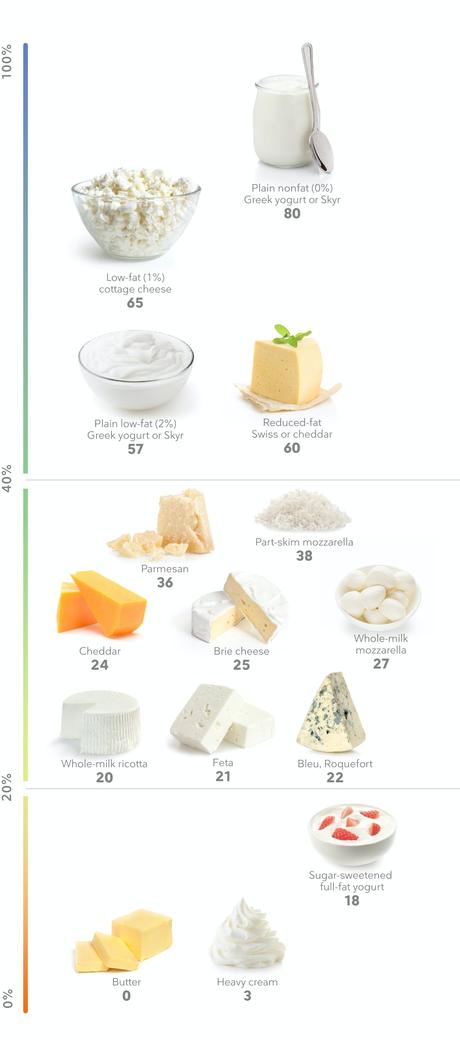
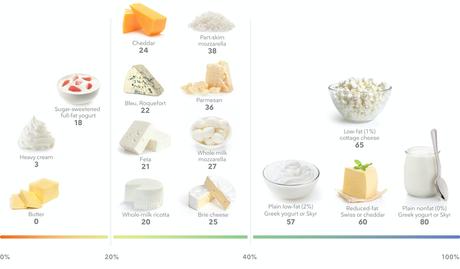
More high-protein guides
More high-protein guides
Protein percentage is key
Your body needs protein to survive and thrive. Of the three macronutrients - protein, carbohydrates (carbs), and fat - only protein is used for building muscle and making vital enzymes.
Eating plenty of protein - including dairy sources - may help you feel full, slightly boost your metabolism, and improve your body composition.
Indeed, many high-protein dairy foods can be great for weight loss.
The key is choosing dairy products with a high protein percentage. This percentage tells you how much of a food's calories come from protein instead of fats and carbs.
It's true that many dairy products provide protein. But if you want to lose weight, you should consider protein percentage when making dairy choices - and we'll show you how. Don't worry, it's easier than it sounds!
For the best weight-loss results, try to choose foods with protein percentages of 35% or more most of the time.
Additionally, aim to eat at least 100 grams of protein per day if you're a woman and 140 grams if you're a man of average height and build. Eat more if you're a man taller than 6 feet (183 cm) or a woman taller than 5 feet 6 inches (168 cm) or if you're very physically active. Eat less if you're shorter or have a petite frame.
While dairy can contribute to your daily goal, you should include other high-protein foods as well, such as meat, seafood, eggs, legumes, and vegetables.
This guide provides both the protein percentages and grams per serving for dairy products.These are based on average values. The protein percentages and gram amounts can vary depending on processing, additives, and other factors. They can also differ slightly among brands.
1. Yogurt
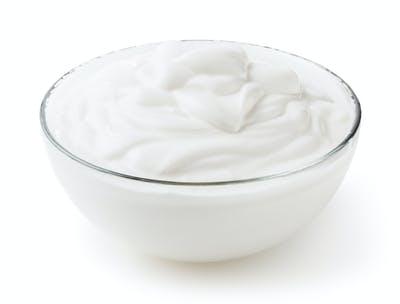
Plain nonfat Greek yogurt or Skyr has the highest protein percentage. However, low-fat Greek yogurt is excellent, too. Full-fat Greek yogurt is also a decent choice. Since they're all high in protein and low in carbs, feel free to eat the kind you like best.
What's the worst option? Any sugar-sweetened yogurt - especially sweetened full-fat yogurt, which is high in both fat and sugar.
The list below provides standard information for different types of yogurt. But it's a good idea to check labels for the protein content, since amounts can vary by brand. Also, look for added sugar - even on "plain" varieties - which decreases a yogurt's protein percentage.
What are those percentages you see on Greek yogurt labels, such as 0%, 2%, or 5%? That's the percentage of a yogurt's weight - which includes water - that comes from fat. This is different from the percentage of a yogurt's calories that come from fat. Only protein, fat, and carbs contain calories. And what is important is protein as a percentage of calories.
For instance, 47% of the calories in full-fat (5%) Greek yogurt come from fat. And 38% of its calories come from protein, as shown in the list below.
Below are the protein percentages and grams of protein and carbs per five-ounce (170-gram) serving of yogurt (about three-quarters of a cup).
*Protein and carb amounts of Greek yogurt vary among brands
2. Cottage cheese
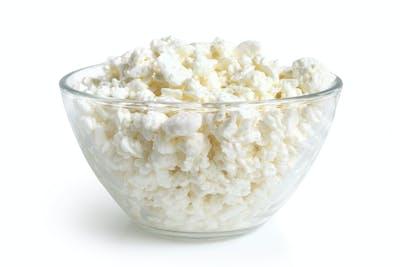
It's made by adding acidic bacteria to milk, which creates curds that give cottage cheese its familiar lumpy appearance.
The good news is that almost all cottage cheese types - including those with more fat - have high protein percentages. The one exception? Cottage cheese with added fruit or sugar.
Just like yogurt, you'll notice different percentages on cottage cheese containers, such as 1%, 2% or 4%. This is the percentage of the cottage cheese's weight (which includes water) that comes from fat. The percentage of calories that come from fat is another matter.
For example, 25% of the calories in low-fat (2%) cottage cheese come from fat. And an impressive 58% of its calories come from protein, as shown in the list below.
Below are the protein percentages and grams of protein and carbs per four-ounce (113-gram) serving of cottage cheese (about one-half cup).
3. Cheese
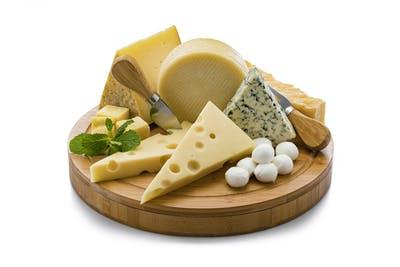
For example, Swiss cheese is considered a high-protein cheese, but its protein percentage is only 27% because it contains a lot of fat.
Fortunately, some reduced-fat cheeses rank pretty high on the protein percentage scale.
Plus, there's no need to avoid the higher-fat cheeses that you love! Just keep portion sizes small and have it occasionally rather than at every meal if weight loss is your goal.
Below are the protein percentages and grams of protein and carbs per 2-ounce (60-gram) serving of cheese (about two slices or one-quarter cup):
4. Milk
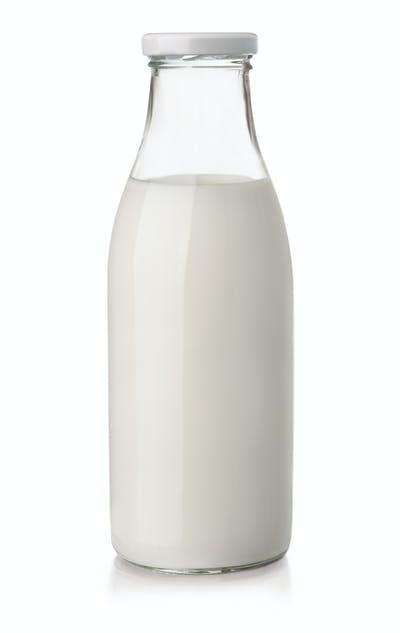
Unlike fermented dairy products, such as cheese and yogurt, milk contains a large amount of lactose (milk sugar), which dilutes its protein content and lowers its protein percentage. Whole milk is higher in both fat and carbs compared to protein, so it ranks near the bottom of the protein percentage list.
Like yogurt and cottage cheese, milk has different percentages on its labels: 1%, 2%, and 3.5%. This is the percentage of a milk's weight (which is mainly water) that comes from fat.
Whole milk (3.5%) contains 48% fat as a percentage of calories. Only 21% of its calories come from protein, as shown in the list below.
High-protein, lower-carb milk is available in the US. But overall, although milk is fine in small amounts, it shouldn't be a staple food - especially if you're trying to lose weight.
What about cream? It contains almost no protein or other nutrients. Use it as needed to add fat and calories.
Below are the protein percentages and grams of protein and carbs per 8-ounce (240-ml) serving of milk (one cup):
- High-protein low-fat (1%) milk Protein percentage:43%
13 grams of protein and 6 grams of carbs per serving
5. Whey protein
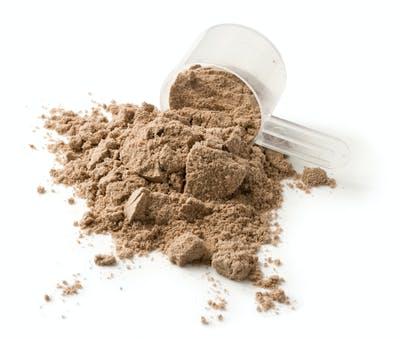
Gram for gram, whey protein contains considerably more protein than other dairy products. It's also a convenient way to get a large protein dose quickly.
On the other hand, it's a highly processed product rather than a minimally processed food. And unlike yogurt, cottage cheese, and cheese, it doesn't provide a lot of vitamins and minerals aside from protein.
We recommend eating high-protein dairy foods rather than whey protein most of the time.However, if you find it challenging to meet your protein needs with food alone, supplementing with whey protein is fine. It is also a convenient way to add more protein to occasional treats like low-carb desserts, bread, and smoothies.
Choose unflavored whey protein powders or types sweetened with stevia or other sugar-free sweeteners.
Which is better: whey protein isolate or concentrate? Whey isolate undergoes further processing known as ultrafiltration, which removes more of the carbs and results in a higher protein percentage. But whey protein concentrate's protein percentage is still impressive at 80%.
Stay away from weight gainer protein powder, though. You'll get very little protein but a lot of carbs and calories.
Below are the protein percentages and grams of protein and carbs per 1-ounce (30-gram) serving of whey protein powder, except where noted:
*Protein percentages of sweetened whey protein powders vary among brands

